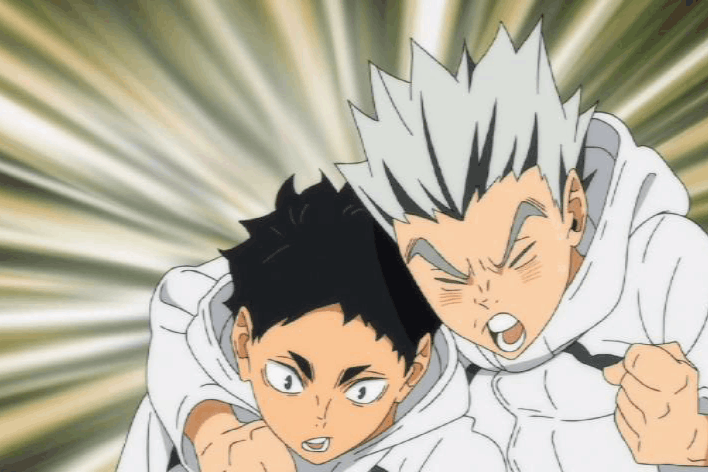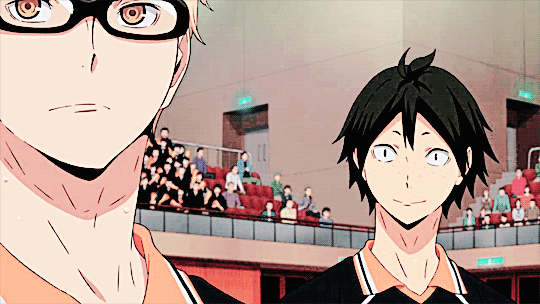Hello everybody! Merie from Imperial Scribis and I joined forces to analyze the character dynamics in one of our favorite shows. (Yes, I know I’ve been talking a lot about Haikyuu recently, but my next post is on something else entirely.)
Character dynamics are something that can truly bring a story to life. Friendships can not only reveal the layers of a character, but they can also play a very large role in character transformation.
There are so many dynamic duos in Haikyuu, but we picked a few of our favorites today to analyze. You’ll see Merie’s wonderful commentary here in this post, and if you want to read mine you can find it at her blog! Click here to read her half of our collaboration.
Let’s get into it, shall we?
Bokuto & Akaashi

Merie: Despite being the captain and ace of a powerhouse team, Bokuto with his wildly temperamental personality would be a huge liability–if it weren’t for Akaashi, whose calm, calculating demeanor offsets Bokuto’s craziness. Their polar-opposite personalities make this friendship fun to watch, but Furudate goes one level deeper and uses the two characters as foils against each other. Throughout the majority of the series, it’s pretty obvious that Bokuto doesn’t really think before he does something (or if he does, it’s most likely to his detriment, as we all remember from his list of weaknesses) and that Akaashi is there to counter that. But this isn’t a one-way thing; Akaashi is the subtler one of the pair, so of course, it’s not going to be clear right away that Bokuto also serves to highlight his weaknesses. But he does!
Besides, who wouldn’t enjoy watching Bokuto break down in the middle of a game, only to have the rest of his team carry on happily without him for a few minutes before Akaashi, having meticulously calculated all the odds and variables of each potential situation, pulls him back to his feet with a well-timed toss that results in a perfect shot. Who wouldn’t, I ask you.
Jorja: Merie is so spot-on with this. Conflicting personalities like Bokuto’s and Akaashi’s work so well to highlight characterization. They’re dynamic is so satisfying to watch.
Yamaguchi & Tsukishima

Merie: In season one, Tsukishima’s role in the team seems pretty unclear (aside from the little bits of foreshadowing here and there). He’s mean and provocative for no reason and never puts much effort into practice, despite being valuable as the tallest member of his team and, according to many of the opponents they face, a very intelligent and logical one. So we start out wondering why Yamaguchi, who acts so earnest and works so hard to improve his serve, follows him around everywhere. Unsurprisingly, like the other characters in the series, Yamaguchi and Tsukishima’s friendship emerged from their shared interest in volleyball. Tsukki’s interest, however, has noticeably flagged since then, whereas Yamaguchi is still working to earn his spot on the team’s starting lineup.
Both Tsukishima and Yamaguchi feel somewhat inferior to their teammates. Yamaguchi is the only one of the first-years who isn’t a regular player, and during the Spring Inter-High tournament, he messed up on his one chance on the court. Tsukishima, on the other hand, feels inferior to Hinata and Kageyama because he doesn’t have their crazy “monster” talents and doesn’t think he’s able to keep up with them. That crucial scene in season two during the Tokyo training camp, in which Yamaguchi finally demands to know why Tsukishima can’t let go of his own baggage and just play, strikes a new contrast between them–Yamaguchi feels a lack of skill and confidence, both of which he’s willing to improve; but Tsukishima feels a lack of talent, something which is impossible to improve. In other words, if Tsukishima didn’t listen to Yamaguchi’s outburst during the Tokyo training camp, Yamaguchi would have eventually surpassed him in playing ability because even though you can never change what you were born with, you can always do something with it.
Jorja: Merie really nails down the motivations of Tsukishima and Yamaguchi here. Or, in Tsukki’s case, lack of motivation.
Hinata & Kageyama

Merie: Okay… where do you even start with these two? Since the series is about them and everything, there’s definitely a lot to talk about. Kageyama and Hinata seem like polar opposites at the start–there you have a dark, broody, angsty dude who’s terrifying on court and has quite the reputation among volleyball schools across the prefecture; and there you have the wild, orange-haired, energetic, completely unknown shrimp who knows next to nothing about the most basic techniques. No, they don’t get along. But remember what Hinata keeps telling Kageyama? “As long as I’m here, you’re invincible.”
They’re also more similar than you’d think. It’s no secret that pretty much every character in this series is a lovable, silly dork on some level (even Akaashi, I rest my case), and of course, these two are at the forefront. Their passion for this sport can only be matched by their total indifference to things like school grades. Hinata’s the first player who can spike one of Kageyama’s infamous “freak” tosses. And, well, Kageyama’s the first setter who can bring Hinata’s full potential out in a game. Together, this crazy duo has become the backbone of Karasuno’s offense, and thanks to them, every opponent they face is guaranteed to be playing against an unpredictable team of ever-changing tactics.
Jorja: I love her point about the similarity of these two characters. Although at first they may seem to be polar opposites, due to their personalities and character design, their passion for volleyball and general dorkiness is definitely something they have in common.
Kuroo & Kenma

Merie: This friendship, at first, appears to be less crucial than others in the story. After all, for most of the story the key scenes of character development among the Nekoma team members occur between laid-back Kenma and his overenthusiastic spikers. But you have to notice that Kenma doesn’t seem much like an athletic kid: he likes to play video games more than volleyball games. On the court, though, he’s the unassuming yet invaluable “brain” of his team, a skilled tactician and a competitive player. We can all thank Kuroo for that.
Kuroo, the much more outgoing and confident captain of Nekoma, is an excellent example of what supportive supporting characters do. We’ve all read or watched the MC and their best friend, a secondary character who should probably have more personality but nah, who cares, we’ll only be paying attention to the love interest anyway. Not so with these two. Kuroo, while sporting vast differences to Hinata, also shares quite a few similarities to the latter, the most critical of them being their willingness to push, or more often than not, shove Kenma into his Challenger Mode (Hinata because he’s totally oblivious to the way he inspires everyone around him to aim high, and Kuroo because he kinda needs Kenma to play for them, and also, because it’s fun). One interesting factor in this dynamic is that we actually see more of their individual relationships with other characters in much of the series than with each other, to the point where their personalities are mostly drawn by those other interactions. Instead of cheapening their friendship, though, this enriches it by introducing them separately and then easily showing them together. So while there are barely any scenes exclusively about Kuroo and Kenma’s friendship, we’re still very familiar with it, and we can understand it perfectly.
Jorja: Kuroo happens to be Merie’s favorite character, so she makes some amazing points about his supportive personality. He’s an amazing leader, and is able to bring the best out of his team, especially Kenma.
The Miya Twins

Merie: Haikyuu does one of the best takes on twins I’ve ever seen. The Miyas have an entirely unforgettable dynamic from the beginning, coupling two equally passionate, equally competitive players… one with a filter and one without. The series has no problem showing us every angle of their bond–the formidable, silly, flawed, and touching sides; their similarities and their differences; the paths they’ll take, both together and individually. In the style of siblings, neither is ever willing to concede to the other except in one thing, and even then it’s hardly a concession.
Furthermore, the twins are described as being the only people who can keep up with each other. Osamu knows when the ball is coming to him, and Atsumu knows he’ll hit it when it’s sent that direction. Neither will let the other give in, constantly challenging and shoving and fighting each other to grow and change and improve in that way all the best friends do. That’s why it kinda hurts when Samu says to Tsumu, “When all’s said and done… you love volleyball just a teensy bit more than I do.”
… On a much lighter note, one has to wonder: which of them is the older twin…?
Jorja: I 100% agree that this is probably my favorite pairs of twins ever written. Their similarities are there, but their differences are where they really shine.
Thanks so much to Merie for collaborating with me and sharing her wonderful analyses! (Also thanks for helping convince me to watch Haikyuu in the first place).
Remember, if you want to check out my analyses of the same duos, hop on over to Merie’s blog!
In the comments, talk to me about some of your favorite fictional duos!
Until next time,


